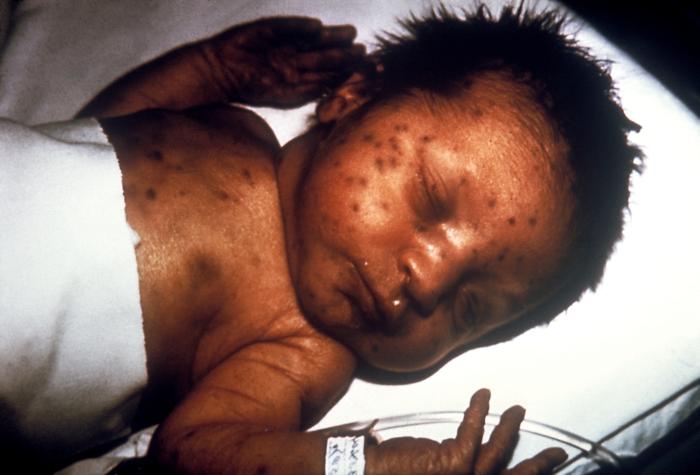🔑 Key Learning
- Rubella infection before 20 weeks gestation has a high risk of congenital rubella syndrome.
-
Varicella exposure in non-immune pregnant women requires prompt assessment:
- Definite history of chickenpox? Reassure.
- Unsure? Check VZV IgG - IgG positive? Reassure.
- No immunity (IgG negative)? 1st line: Oral antivirals (aciclovir or valaciclovir) to be given from day 7 to 14 post-exposure
- Aciclovir is recommended for active varicella infection in pregnancy, especially if >20 weeks.
- Congenital toxoplasmosis and CMV can cause CNS and sensory complications in the neonate.
🌸 Rubella in Pregnancy
Rubella is a notifiable viral illness that poses significant teratogenic risk in pregnancy, particularly in the first 20 weeks.
Clinical Features
Symptoms develop 2–3 weeks post-exposure:
- Pink/light red rash beginning on face and neck, spreading downwards
- Lymphadenopathy (especially postauricular and suboccipital)
- Arthralgia
- Low-grade fever, malaise, and URTI symptoms
Congenital Rubella Syndrome
- Sensorineural deafness (most common feature)
- Ocular abnormalities: cataracts, chorioretinitis ("salt and pepper" retina)
- Cardiac defects: patent ductus arteriosus (PDA)
- CNS: microcephaly
- Hepatosplenomegaly
- Blueberry muffin rash (extramedullary haematopoiesis)

Assessment and Management
- Notify health protection team immediately - Rubella is a notifiable disease
- If woman is IgG negative: advise avoidance of exposure, and offer MMR vaccine postnatally
-
IgM positive confirms recent infection
- Refer to obstetrics immediately if rubella is confirmed
Risk by gestational age:
- <10 weeks: 90% risk of CRS
- 11–20 weeks: risk of CRS declines with gestation
-
20 weeks: reassure, risk of congenital rubella is negligible
🧬 Varicella Zoster Virus in Pregnancy
Prevention of Varicella in Exposed Pregnant Women
Step 1: Risk Assessment
- History of prior varicella or vaccination - if certain - reassure
Step 2: Serology
- If uncertain immunity or from tropical/subtropical countries (more likely to be seronegative): check VZV IgG levels
- If IgG positive: patient is immune → reassure
- If IgG negative: non-immune → proceed to post-exposure prophylaxis (below)
Post-Exposure Prophylaxis (Updated 2024)
- 1st line: Oral antivirals (aciclovir or valaciclovir) to be given from day 7 to 14 post-exposure
- If contraindicated: VZIG can be offered (effective up to 10 days post-exposure)
Management of Active Chickenpox During Pregnancy
-
Oral aciclovir if presenting up to 24 hours from rash onset and >20 weeks gestation
- Also 'consider' aciclovir before 20 weeks after discussion w/ specialist
- Severe disease: IV aciclovir is required
Additional Notes
- VZIG is not useful once the rash has appeared
- Aciclovir and valaciclovir are not licensed in pregnancy but are recommended based on benefit-risk balance
Referral and Follow-up
- Foetal medicine referral at 16–20 weeks or 5 weeks post-infection - detailed US
- Consider amniocentesis for varicella DNA PCR only after lesions have resolved
🐈 Congenital Toxoplasmosis
Causes
- Can be caught through contact with cat faeces or undercooked meat.
- Advise to (1) avoid contact w/ cat faeces - someone else in household to clean litter box etc. (2) eat well-cooked meat and avoid raw/cured meats
Clinical Features
- Chorioretinitis
- Hydrocephalus
- Intracranial calcification
🦠 Congenital Cytomegalovirus (CMV)
Clinical Features
- Intrauterine growth restriction
- Microcephaly and neurodevelopmental delay
- Sensorineural hearing loss
- Visual loss
- Seizures
📝 Exam Clues & Clinchers
- Rubella before 10 weeks gestation: 90% risk of CRS
- Blueberry muffin rash: think rubella
- VZV IgG negative pregnant woman: offer oral antivirals (aciclovir) between day 7–14 after exposure
- Toxoplasmosis triad: chorioretinitis, hydrocephalus, intracranial calcifications
